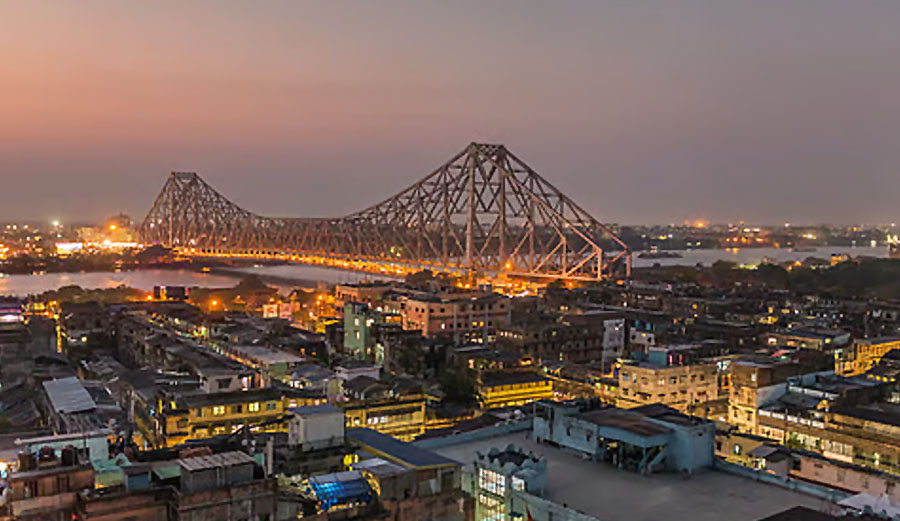The Howrah Bridge became operational on 3rd February 1943. A solo tram was the first traveler on the bridge.
However, the Howrah Bridge was not formally inaugurated as the British authorities were afraid that the Japanese might bomb the bridge as the second world war was going on.
Even today, it is the most prominent symbol of Kolkata. There is hardly a better example of two cities joined by a bridge over the Ganges in India.
In fact, an iconic film named Howrah Bridge was made in 1958, just 15 years after the bridge became operational. In 2018, a Telugu film with a similar title, Howrah Bridge, was also made.
It seems that the romance of the filmmakers with the bridge is never-ending. Even in recent times, quite a few Bollywood films used the bridge as the backdrop in different scenes.
In fact, Howrah Bridge and the city provide a great locational setting for Bollywood as always. The makers of Yuva (2004), originally titled Howrah Bridge, Parineeta (2005), Love Aaj Kal (2009), Kahaani (2012), Barfi! (2012), Lootera (2013), Gunday (2014), Piku (2015), Detective Byomkesh Bakshy! (2015), Te3n (2016), and Meri Pyaari Bindu (2017) have chosen different routes to wend their way around the city, but none of them ever left without weaving the bridge into their respective narratives on one pretext or the other.
The bridge also featured in Ritwik Ghatak’s Bari Theke Paliye in 1958, Satyajit Ray’s Parash Pathar in the same year, Mrinal Sen’s Neel Akasher Neechey in 1959.
In fact, the bridge is featured in a lot many other films in different languages in Indian and foreign productions..
The Howrah Bridge is an essential element of Kolkata’s skyline. The beautiful bridge, connecting the twin cities of Kolkata and Howrah, was constructed in the British period.
There are quite a few interesting facts about the bridge, and we will know some of them shortly.
An Engineering Marvel
The Howrah Bridge is a cantilever bridge that is supported only from one end and stands horizontally, which makes it a wonderful example of engineering and aesthetics.
When under construction, it was the third-largest cantilever bridge in the world. Today, it is the sixth-longest bridge in this category.
It is the longest cantilever bridge in the country. Howrah Bridge has a 457 m long span.
There are no nuts and bolts used in the making of this bridge, as it is made out of rivets throughout the structure.
A total of 26,500 tons of steel was used in the construction of the bridge. Out of this, 23,000 tons of steel was supplied by Tata Steel at Jamshedpur, India.
An Essential Part of Connectivity
Chandragupta Maurya, the founder of the ancient Indian Maurya Empire, built this highway along an ancient route called Uttarapatha in the 3rd century BCE, extending it from the mouth of the Ganges to the north-western frontier of the Empire. Further improvements to this road were made under Ashoka.
The old route was re-aligned by Sher Shah Suri to Sonargaon and Rohtas. The Afghan end of the road was rebuilt under Mahmud Shah Durrani. The road was considerably rebuilt in the British period between 1833 and 1860.
Later on, when Kolkata was established as the capital of British India, it was necessary to build a bridge connecting Kolkata and Howrah. It was possible to travel to any part of the country from Howrah.
Even today, if you you like to travel to any part of India by train, you must come to Howrah Station. This is the mega station from where most trains to North, South, Central, and West India start.
The best way to travel to Howrah station is the Howrah Bridge. Today, the Howrah Bridge handles a daily traffic of around 100,000 vehicles and 150,000 pedestrians.
This makes the bridge one of the busiest cantilever bridges in the world.
80 Years Young, Still Going Strong
The people of Kolkata absolutely love the biggest icon of their city, the Howrah Bridge. This is the most prominent icon to visually symbolize Kolkata.
In fact, Kolkata loves the Howrah Bridge so much that they associated the bridge with the greatest icon of Bengalis, Gurudev Rabindranath Tagore. In 1965, the Howrah Bridge was renamed Rabindra Setu. However, it is still popularly called the Howrah Bridge.
The bridge faces the danger from bird droppings and people spitting on it. Kolkata Port Trust, entrusted with the maintenance of the bridge, spends close to Rs. 5,00,000 annually to regularly clean them out.
Even heavy vehicles are not allowed on the bridge now and they are redirected to use the second Hooghly Bridge, Vidyasagar Setu.
There is a need to reduce vehicular load on the bridge and several measures are taken for that.
The East-West Metro will be a Game Changer
Every day, a large number of people arrive at the Howrah station from various locations on the suburban rail network around Howrah. Almost all of them need to go to their workplaces in Kolkata.
They travel to their destinations by public transport, mostly buses, and this crowd of buses creates a traffic snarl on the bridge. The same happens when they return home in the evening after the workday ends.
Well, some people avail of the ferry service across the river and this does not take away significant load away from the bridge.
But all these are going to change when the East-West Metro becomes operational. It is expected that the Howrah Esplanafe stretch will be operational by the end of this year.
It will be fairly easy to travel to the business districts of BBD Bag and the Park Street-Camac Street area by Metro and there will be much less vehicular load on the good old Howrah Bridge.
Finally, after decades, there will be some respite for the bridge and the Metro will be the main way to travel as far as the Salt Lake Sector 5 when the entire East-West Metro is operational.
But the Howrah Bridge, Rabindra Setu, will always remain a part of the city’s soul.






